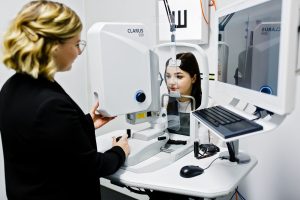Many Australians lose part or all their sight as a result of diabetes.
This happens because nearly half of all Australians with diabetes aren’t having regular diabetes eye checks.
There are several reasons for this. Managing diabetes can be difficult and requires a range of different health checks. Some people don’t know they need to get their eyes checked. Others struggle to fit it into their busy lives.
Eye health
- If you have diabetes, it is likely that you will develop some changes to your eyes.
- Diabetes sometimes causes the focusing ability of the eye to weaken or to vary from day-to-day; however, this problem eases when blood glucose levels are stable.
- Diabetes can also cause vision loss from Diabetes Retinopathy (damage to the very small blood vessels on the back of the eye).
Diabetic Retinopathy

The risk of developing diabetic retinopathy increases with the length of time you have had diabetes. The risk is also increased when blood glucose levels are not well controlled over time. Good blood glucose levels and blood pressure, and regular comprehensive eye examinations can greatly reduce the risk of developing diabetic retinopathy but it does not eliminate it.
Diabetic Retinopathy can occur regardless of the type of diabetes you have, your age, or even the control you have over your blood-glucose levels. It’s best to have regular eye examinations so that changes can be detected and treated early. People who have diabetes should have their eyes checked from when diabetes is first diagnosed, and then regularly checked every year.
Symptoms Diabetic Retinopathy
If you notice any changes in your vision contact your Optometrist. Some examples of symptoms of Diabetic Retinopathy include:
- Blurred, distorted or patchy vision that can’t be corrected with prescription glasses
- Problems with balance, reading, watching television and recognising people
- Being overly sensitive to glare
- Difficulty seeing at night.
In the early stages of Diabetic Retinopathy there may be no symptoms and the disease may not be diagnosed until it is advanced.
Double vision
This is a rare complication of diabetes. Double vision is usually temporary but it may last for a few months. An optometrist can help treat it while it has effect. Diabetes is not the only cause of double vision.
Glaucoma
In Australia, more than 300,000 people live with glaucoma, also known as the ‘silent thief of sight’. Glaucoma is when the main nerve in your eye thins, causing loss of your side vision. If left untreated it can cause tunnel vision/blindness. It’s estimated over 50% of people who develop the condition don’t know they have it until it’s too late.
Although anyone can develop glaucoma, some people are at greater risk. Diabetes is one of these risk factors.
Looking after your eyes
To look after your eyes and help prevent vision loss:
- Have your eyes checked regularly, every year, to pick up early signs of damage
- Control your blood glucose levels.
- Maintain a healthy blood pressure and cholesterol levels
- If your vision has been affected, seek treatment from your Optometrist to stop it from getting worse.
Who can test your eyes?

You should have a comprehensive eye health examination from an Optometrist. All results can be sent through to your Doctor or specialist.
Treatment
If the damage is detected before it has affected your sight, treatment can prevent vision loss. Where vision loss has already occurred, treatment can only stop it from getting worse.












